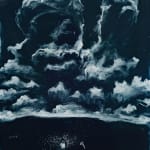


Themba Khumalo
(untitled monoprint), 2025
Monoprint
100 x 71 cm
framed 114 x 85 x 5.5 cm
framed 114 x 85 x 5.5 cm
Further images
Imvelaphi, a word closely translated as 'origin' or 'birthplace', extendsbeyond a physical beginning to encompass the roots of religion, culture, andidentity. My latest exhibition explores these interconnected themes, focusingon the...
Imvelaphi, a word closely translated as "origin" or "birthplace", extendsbeyond a physical beginning to encompass the roots of religion, culture, andidentity. My latest exhibition explores these interconnected themes, focusingon the act of honouring and remembering past cultural practices, and tracingtheir continuous evolution into modern life. The land itself is a centralwitness, bearing the marks and scars of this history.
This presentation also serves as a preservation of language, contrasted withimage-making using natural materials: charcoal and coffee. These materialsare deeply symbolic. Coffee mimics the rich tones of the earth (Umhlaba),connecting us to the land. Charcoal, a product of fire, represents the markingof legacy and the preservation of history, much like the ancient scripts andimages created by our forefathers using organic matter.I approach these themes with the belief that mark-making can serve as botha physical and metaphysical record of these contested spaces.
My workintends to challenge viewers to reconsider their relationship to land,particularly in a post-apartheid context, and to reflect on how it shapes ourcollective identity and individual histories.Printmaking is central to my process, as it mirrors how land bears layeredhistories. Techniques like etching or woodcuts require intentional, physicalforce, echoing the scars and stories embedded in the earth. The repetitioninherent in printmaking reflects history’s cyclical nature.
The recurring figurein white represents uMthandazi, the spiritual cleanser, healer, andmessenger of prayer to the Higher power, whose prominent presencethroughout the work underscores this spiritual dimension.
This presentation also serves as a preservation of language, contrasted withimage-making using natural materials: charcoal and coffee. These materialsare deeply symbolic. Coffee mimics the rich tones of the earth (Umhlaba),connecting us to the land. Charcoal, a product of fire, represents the markingof legacy and the preservation of history, much like the ancient scripts andimages created by our forefathers using organic matter.I approach these themes with the belief that mark-making can serve as botha physical and metaphysical record of these contested spaces.
My workintends to challenge viewers to reconsider their relationship to land,particularly in a post-apartheid context, and to reflect on how it shapes ourcollective identity and individual histories.Printmaking is central to my process, as it mirrors how land bears layeredhistories. Techniques like etching or woodcuts require intentional, physicalforce, echoing the scars and stories embedded in the earth. The repetitioninherent in printmaking reflects history’s cyclical nature.
The recurring figurein white represents uMthandazi, the spiritual cleanser, healer, andmessenger of prayer to the Higher power, whose prominent presencethroughout the work underscores this spiritual dimension.
Exhibitions
2025 Imvelaphi Solo Exhibition, Candice Berman Gallery, Johannesburg, South AfricaJoin our mailing list
* denotes required fields
We will process the personal data you have supplied in accordance with our privacy policy (available on request). You can unsubscribe or change your preferences at any time by clicking the link in our emails.


